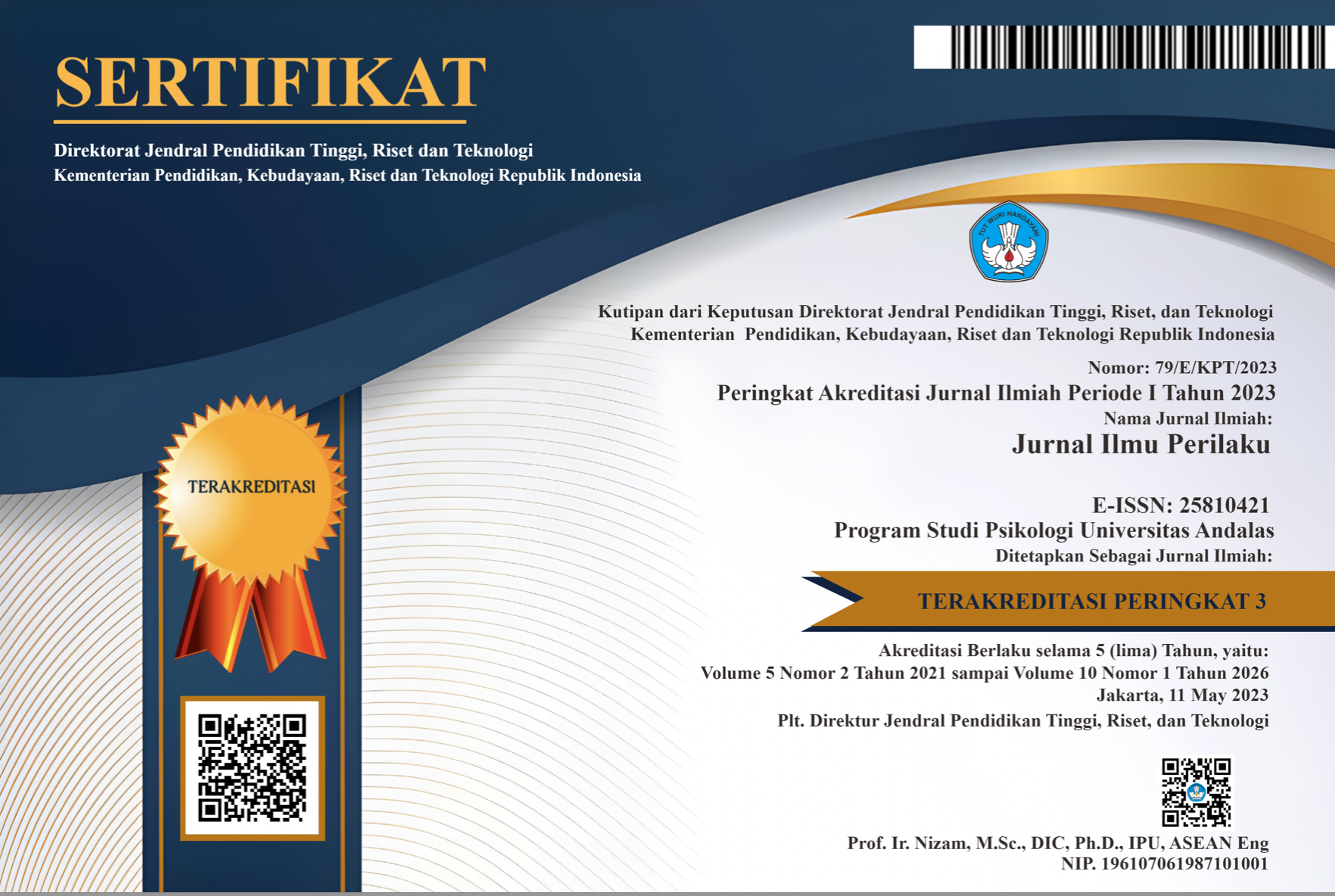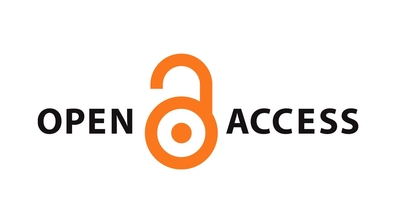Mindfulness sebagai Mediator Fear of Missing Out dan Problematic Internet Use pada Penduduk Asli Digital
Abstract
The development of internet technology creates a new need for digital natives in order to stay online. The desire to stay connected due to not to be left behind by trends and information is known as fear of missing out (FoMO), thus individuals getting more involved in problematic internet use (PIU). Mindfulness is believed to influence how the relationship between FoMO and PIU. This research aims to know the role of mindfulness as a mediator of the relationship between FoMO and PIU. The number of research subjects were 286 people with age range 17-25 years old in Jakarta. The research method is quantitative. Data were collected using the FoMO scale questionnaire, Mindful Attention Awareness Scale (MAAS), and Generalized Problematic Internet Use Scale 2 (GPIUS 2). Analysis technique used was path analysis. The results revealed that mindfulness did not perfectly mediate FoMO and PIU. However, the path is in line between the variables, which there is a negative relationship between FoMO and mindfulness, mindfulness negatively related to PIU and FoMO positively coorelated to PIU.
Downloads
References
Asosiasi Penyelenggara Jasa Internet Indonesia. (2018). Laporan survei penetrasi & profil perilaku pengguna internet Indonesia. Retrieved from https://apjii.or.id/survei
Autry, A. J., & Berge, Z. (2011). Digital natives and digital immigrants: Getting to know each other. Industrial and Commercial Training, 43(7), 460–466. https://doi.org/10.1108/00197851111171890
Baker, Z. G., Krieger, & LeRoy, A. S. (2016). Fear of Missing Out: Relationships With Depression, Mindfulness, and Physical Symptoms. Translational Issues in Psychological Science, 2 (3), 275–282. Doi: http://dx.doi.org/10.1037/tps0000075
Baron, R. M., & Kenny, D. A. (1986). The Moderator-Mediator Variable Distinction in Social Psychological Research. Conceptual, Strategic, and Statistical Considerations. Journal of Personality and Social Psychology, 51(6), 1173–1182. https://doi.org/10.1037/0022-3514.51.6.1173
Brown, K. W., Ryan, R. M & Creswell, J. D. (2007). Mindfulness: Theoretical foundations and evidence for its salutary effects. Psychological Inquiry, 18(4), 211-237, DOI: 10.1080/10478400701598298
Burke,M.,Marlow,C.,&Lento,T.(2010).Social network activity and social well- being.Postgraduate Medical Journal, 85 ,455–459.
Calvete, E., Games-GUadix, M., Cortazar, N. (2017). Mindfulness facets and problematic internet use: A six-month longitudinal study. Addictive Behaviors, 72, 57-63.
Caplan, S. E. (2002). Problematic Internet use and psychosocial well-being: Development of a theory-based cognitive- behavioral measure. Computers in Human Behavior, 18, 533-578. doi: 10.1016/j.chb.2009.06.006.
Caplan, S. E. (2010). Theory and measurement of generalized problematic Internet use: A two-step approach. Computers in Human Behavior, 26, 1089-1097. doi: 10.1016/j.chb.2010.03.012
Caplan, S. E., & High, A. C. (2012). Online Social Interaction, Psychosocial Well-Being, and Problematic Internet Use. Internet Addiction, 35–53. https://doi.org/10.1002/9781118013991.ch3
Choi, Y.S. and Ross, L. (2006) Policy and Power: The Impact of the Internet on the Younger Generation in South Korea. Social Policy and Society, 5, 421-429.
Davis, R. A. (2001).A cognitive-behavioral model of pathological internet use. Computer in Human Behavior,17: 187-195. doi: 10.1016/S0747-5632(00)00041-8.
Gámez-Guadix, M., & Calvete, E. (2016). Assessing the relationship between mindful awareness and problematic Internet use among adolescents. Mindfulness, 7(6), 1281–1288. http://dx.doi.org/10.1007/s12671-016-0566-0.
Kittinger, R., Correia, C. J., & Irons, J. G. (2012). Relationship between facebook use and problematic internet use among college students. Cyberpsychology, Behavior, and Social Networking, 15(6), 324–327. https://doi.org/10.1089/cyber.2010.0410
Kraut, R., Kiesler, S., Boneva, B., Cummings, J., Helgeson, V.,& Crawford, A. (2002). Internet paradox revisited. Journal of Social Issues, 58, 49-74. doi:10.1111/1540-4560.00248.
Lampe, C.,Ellison,N.,&Steinfield,C.(2007).A familiar face (book):Profile elements assignals in an online social network. InCHI Proceedings .New York,NY:ACM.
Lim, M. (2004). The Internet , Social Networks , and Reform in Indonesia The Internet : A Convivial Medium for Civil Society. 273–288.
Lynch, S. (2014, Okt 03). How mindfulness is the key to end your FoMO. Newstalk. Diakses dari https://www.newstalk.com/news/why-mindfulness-can-help-relieve-your-fomo-fear-of-missing-out-687531
Meerkerk, G.J., VanDen Eijnden, R. J., & Garretsen, H.F. (2006). Predicting compulsive Internet use: It’s all about sex! Cyberpsychology & Behavior, 9, 95-103. doi:10.1089/cpb.2006.9.95
Pertiwi, W. . (2018). Riset Ungkap Pola Pemakaian Medsos Orang Indonesia. Kompas. https://tekno.kompas.com/read/2018/03/01/10340027/riset-ungkap-pola-pemakaian-medsos-orang-indonesia
Prensky, M. (2001). Digital natives, digital immigrants. In On the horizon (Vol. 9, Issue 5, pp. 1–6). MCB University Press.
Przybylski, A. K., Murayama, K., Dehaan, C. R., & Gladwell, V. (2013). Motivational, emotional, and behavioral correlates of fear of missing out. Computers in Human Behavior, 29(4), 1841–1848. https://doi.org/10.1016/j.chb.2013.02.014
Reyes, M. E. S., Marasigan, J. P., Gonzales, H. J. Q., Hernandez, K. L. M., Medios, M. A. O., & Cayubit, R. F. O. (2018). Fear of missing out and its link with social media and problematic internet use among filipinos. North American Journal of Psychology, 20(3), 503–518.
Reynaldo, R., & Sokang,Y.A.(2016). Mahasiswa dan Internet: Dua Sisi Mata Uang? Problematic Internet Use pada Mahasiswa. Jurnal Psikologi, 43(2), 107-120. https://doi.org/10.22146/jpsi.17276
Shonin, E., Van Gordon, W., & Griffiths, M. D. (2014). Mindfulness and the social media. Journal of Mass Communication and Journalism, 4(5). Doi: 10.4172/2165-7912.1000194.
Turkle, S. (2011). Alone together: Why we expect more from technology and less from each other. New York: Basic Books.
Vaidya, N., Jaiganesh, S., & Krishnan, J. (2016). Prevalence of internet addiction and its impact on the physiological balance of mental health. National Journal of Physiology, Pharmacy and Pharmacology, 6(1), 97–100. https://doi.org/10.5455/njppp.2015.5.0511201588
Whang, L. S. M., Lee, S., & Chang, G. (2003). Internet over-users’ psychological profiles: A behavior sampling analysis on Internet addiction. Cyberpsychology and Behavior, 6(2), 143–150. https://doi.org/10.1089/109493103321640338
Yang, C. Y., Sato, T., Yamawaki, N., & Miyata, M. (2013). Prevalence and risk factors of problematic Internet use: A cross-national comparison of Japanese and Chinese university students. Transcultural Psychiatry, 50(2), 263–279. https://doi.org/10.1177/1363461513488876
Young, K.S (1996). Addictive use of the Internet: A case that breaks the stereotype. Psychological Reports, 79(3), 899–902. https://doi.org/10.2466/pr0.1996.79.3.899
The non-commercial use of the article is governed by the Creative Commons Attribution license as currently displayed on Creative Commons Attribution-NonCommercial-ShareAlike 4.0 International License.
JIP's spirit is to disseminate articles published are as free as possible. Under the Creative Commons license, JIP permits users to copy, distribute, display, and perform the work for non-commercial purposes only. Users will also need to attribute authors and JIP on distributing works in the journal.
Please find the rights and licenses in Jurnal Ilmu Perilaku (JIP).
- License
The non-commercial use of the article will be governed by the Creative Commons Attribution license as currently displayed on Creative Commons Attribution-NonCommercial-ShareAlike 4.0 International License.
- Author’s Warranties
The author warrants that the article is original, written by stated author(s), has not been published before, contains no unlawful statements, does not infringe the rights of others, is subject to copyright that is vested exclusively in the author and free of any third party rights, and that any necessary written permissions to quote from other sources have been obtained by the author(s).
- User Rights
JIP's spirit is to disseminate articles published are as free as possible. Under the Creative Commons license, JIP permits users to copy, distribute, display, and perform the work for non-commercial purposes only. Users will also need to attribute authors and JIP on distributing works in the journal.
- Rights of Authors
Authors retain the following rights:
- Copyright, and other proprietary rights relating to the article, such as patent rights,
- The right to use the substance of the article in future own works, including lectures and books,
- The right to reproduce the article for own purposes, provided the copies are not offered for sale,
- The right to self-archive the article.
- Co-Authorship
If the article was jointly prepared by other authors, the signatory of this form warrants that he/she has been authorized by all co-authors to sign this agreement on their behalf, and agrees to inform his/her co-authors of the terms of this agreement.
- Termination
This agreement can be terminated by the author or JIP upon two months’ notice where the other party has materially breached this agreement and failed to remedy such breach within a month of being given the terminating party’s notice requesting such breach to be remedied. No breach or violation of this agreement will cause this agreement or any license granted in it to terminate automatically or affect the definition of JIP.
- Royalties
This agreement entitles the author to no royalties or other fees. To such extent as legally permissible, the author waives his or her right to collect royalties relative to the article in respect of any use of the article by JIP or its sublicensee.
- Miscellaneous
JIP will publish the article (or have it published) in the journal if the article’s editorial process is successfully completed and JIP or its sublicensee has become obligated to have the article published. JIP may conform the article to a style of punctuation, spelling, capitalization, referencing and usage that it deems appropriate. The author acknowledges that the article may be published so that it will be publicly accessible and such access will be free of charge for the readers.










